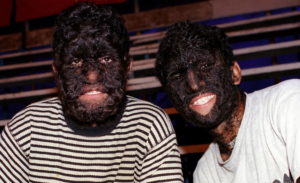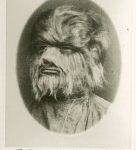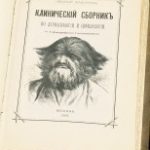The Curious Genetics of Werewolves

Growing up in the 1960s, I collected monster cards: The 60-foot-man and the 50-foot woman, duplicate bodies gestating in giant seed pods, unseen Martians that sucked children into sand pits and returned them devoid of emotion, with telltale marks on the back of the neck. One card featured a very young Michael Landon in “I Was a Teenage Werewolf.”
Forgive my lapse in political correctness, but I recalled those cards when I saw the word “hypertrichosis” in a recent paper in PLOS Genetics, because, unfortunately, the condition is also known historically as “werewolf syndrome.”
In the paper, geneticist Angela Christiano, PhD, and colleagues at Columbia University analyzed the genomes of a father and son with Ambras syndrome, a form of hypertrichosis – and found something intriguing about the causative mutation that has repercussions for genetic testing in general.
A WEREWOLF PRIMER
Before a genetic explanation for overactive hair follicles existed, werewolfism, aka lycanthropy, was thought to arise in eclectic ways: rubbing a magic salve into the skin, sleeping outdoors under a summer full moon, drinking from the pawprint of a wolf, or a devil’s curse. Werewolves were once considered to be giant extinct lemurs from Madagascar.
Armenian folklore describes a werewolf as a female criminal being punished by coming out at night and eating her children, and then her relatives’ children, in order of relatedness.
In 1963 a physician in London, where Warren Zevon tells us werewolves are prevalent, ascribed lycanthropy to the very rare blood disease congenital erythropoietic porphyria. With its attendant hairiness, reddish teeth, pink urine, and aversion to bright light, porphyria would later explain vampires too, although that idea has been discredited.
Some physicians suggested that hypertrichosis causes lycanthropy, but others argued that the genetic condition was too rare to account for the many werewolves loose on the streets of Europe.
ONLY 50 CASES KNOWN
Sources say that Ambras syndrome affects fewer than one in a billion people, and that only 50 cases have been described since the Middle Ages.
The name Ambras comes from Petrus Gonzales, who at age 12 in 1556 was brought as a slave from Tenerife in the Canary Islands to the court in France. He had a strikingly hairy face, married young, and had 4 children, 3 of whom were born hairy. His daughter Tognina and son Arrigo passed on the trait. Royalty, who called Petrus the “man of the woods,” thought he represented a race of hairy people from the Canary Islands. The celebrated family sat for many portraits, and one, displayed at a castle near Innsbruck called Ambras, led to their notoriety as the “family of Ambras,” and eventually their condition as “Ambras syndrome”. (An image of a little girl from the family graces the cover of Armand Marie Leroi’s fabulous book Mutants).
Shwe-Maong was another noted person with Ambras syndrome, from Burma. Wrote an observer in 1826: “… the whole face, with the exception of the red portion of the lips, were covered with fine hair.” The hairs were 4 to 8 inches long, straight and silky.
Born in the hill country outside the capitol, people encouraged Shwe-Maon to whoop like a monkey and act dumb. Like Petrus, he became a royal favorite, given a wife at a young age. They had 4 children, including a girl whose entire body was covered in a pelt of long, silky grey hair. Her name was Maphoon. She married and had two hairy sons, one of whom passed on the trait.
Charles Darwin mentioned Maphoon in The Descent of Man and Selection in Relation to Sex (1859), but it was his readers who brought up that the striking hairiness was atavistic, a turning-on of an ancestral trait silenced through evolutionary time. But the quality of the hair isn’t like that of an orangutan or gorilla. It‘s silky, and covers places, especially on the face, where our ape cousins don’t have hair. People with Ambras syndrome aren’t throwbacks.
Some individuals with Ambras syndrome ended up in circus sideshows, such as Julia Pastrana, the “bearded lady” who toured Europe and North America in the 1850s. In 1884 PT Barnum exhibited 16-year-old Fedor Jepticheff as “Jo-Jo the dog-faced man,” who became the inspiration for Disney’s Beast and a Phish song. Jo-Jo played along, barking on cue for PT Barnum, although he was very intelligent and made quite a good living from his genetic misfortune.

Documentation of Ambras syndrome appears in the medical literature a generation after Jo-Jo, when Russian dermatologist Nikolai Mansurov (1834–92) took photographs and commissioned wood carvings to illustrate an article on “hairy people,” then called polytrichia.
Lycanthropy may also be a delusion. A report in the November 1975 issue of the Canadian Psychiatric Association Journal described 20-year-old Mr. H, who claimed that after ingesting strychnine in a forest in Europe while serving in the military, he suddenly grew fur on his face and hands and was overwhelmed with a craving to eat live rabbits.

People with Ambras syndrome still occasionally make the news. In 2011 the Guinness Book of World Records listed Supatra (“Nat”) Sasuphan, a 12-year-old from Thailand, as the “world’s hairiest girl.” She considers this a step up from being called “wolf girl” and “monkey face.” Since her birth, long silky grayish hair has cascaded down her face, like a veil starting at her bushy eyebrows.
Earlier this year a mother and her 3 children taunted for their “werewolf syndrome” sought help in Nepal and YouTube
features several other families with Ambras syndrome.
BACK TO BIOLOGY
Ambras syndrome is a disruption of the crosstalk between the epidermis and the dermis as hair follicles form in the 3-month fetus at the eyebrows and spread down to the toes. Signals from the dermis send the messages to form follicles. As a follicle forms, it sends signals to prevent the area around it from also becoming a follicle, establishing equal spacing of our 5 million or so follicles. Most body parts ignore the messages to form follicles, and so we’re relatively hairless.
An area called the bulge about halfway down each follicle houses the stem cells that keep hair growing. Hairs cycle through phases. In anagen (growth phase) cells divide, for 2 to 6 years. In catagen, which lasts about 2 weeks, the follicle renews itself. Telogen is a 1-4 month long rest. About 85% of our hairs are in anagen at any given time, 10-15% in telogen, and a few in the transitional stage of catagen.
Human hairs are of a different quality in the scalp, brows, lashes, and pubic area. And our hair is of three basic types. Lanugo is the fuzz that coats a fetus, and may cling to the newborn. Vellus is the fine and light hair on most of the body, seen on the arms and faces of children. Terminal hair, the third type, is on the scalp and forms the eyebrows and lashes.
In Ambras syndrome, vellus hair streams down the face and curls from the ears, flowing down the shoulders. Facial features are coarse, the nose long, and the face triangular. Teeth may be absent, fingers and nipples extra.
THE BIGGER PICTURE – WHEN IS A MUTATION A MUTATION?
Since the official naming of Ambras syndrome in 1993, several studies have implicated a site on the short arm of chromosome 8, where individuals had inverted or deleted genetic material.
The responsible gene, Trps1, is a zinc finger transcription factor that regulates a suite of genes involved in hair and bone development. One of the genes it regulates is Sox9, which in turn regulates stem and progenitor cells in the bulge region of the developing hair follicle.
In a 2004 paper, Dr. Christiano and colleagues described a “position effect” behind Ambras syndrome. That is, DNA elsewhere can alter the expression of Trps1, and that of the genes it controls. Their 2012 paper unravels the genetic controls behind the position effect.
Whole genome SNP arrays on a father and son with Ambras syndrome revealed a 1½-million-base-long duplicated stretch of DNA between Sox9 on chromosome 17 and the chromosome tip, like a repeated paragraph near the end of a book. And so the position effect is on one of the genes that Trps1 regulates.
The idea of a position effect isn’t new – I remember it from my Drosophila days in the 70s; fly eyes had patches of different colors because a gene had been moved to a different chromosomal address. Position effects could cause problems with the interpretation of sequenced genomes.
The key word is sequence, because the classic Ambras cases with inverted chromosome 8s and the variegated fly eyes indicate that a gene’s neighborhood affects what it does. Copy numbers also affect gene expression – like the big duplication in the Ambras father and son who have normal Trps1 genes. Genome sequencing technology is beginning to include copy number variant analysis, but detecting rearrangement breakpoints – such as inversions and translocations — is still a challenge, and in fact recently complicated the sequencing of fetal genomes.
The Ambras position effect reminds me of another recent paper that found the opposite: “Deleterious- and Disease-Allele Prevalence in Healthy Individuals: Insights from Current Predictions, Mutation Databases, and Population-Scale Resequencing.”
As part of the 1000 Genomes Consortium, researchers checked the genomes of 179 people against mutation databases. And it turns out that even healthy folk have lots of mutations. Apparently redundancies built into our genomes can protect us.
Here’s the deal:
a. You can have a mutation (a disease-causing genotype), yet not be sick.
b. You can be sick, yet not have the associated disease-causing genotype.
c. You can be sick and have a causative mutation.
d. All of the above, for many different genes
So just as people are starting to get their genomes sequenced as prices tumble, uncertainty, albeit based on long-known concepts of genetics, blooms. And unfortunately people taking direct-to-consumer genetic tests, or even some health care professionals who are asked to interpret test results, may not be all that familiar with the fact that DNA science doesn’t always yield clear answers.
Will a consumer using testing websites learn enough about the subtleties of genetics to realize that a test result is not a crystal ball? Will the increasing delivery of genetic counseling services via videos or the phone suffice to convey the inherent uncertainty?
Like any pioneers, the first few thousand people to have their genomes sequenced will get a lot of this gray-area information. But the only way we’re going to learn what all of our gene variants mean is to decipher all possible gene interactions, and all possible perturbations, including sequences, copy number variants, and rearrangements. And that will require many more genome sequences.
If genetic analysis is not clear cut for a phenotype and inheritance pattern as obvious as those of Ambras syndrome, how will we understand the many common conditions that reflect the inputs of many genes, interacting in ways we may not yet even understand?
As in all things scientific, and despite the evolution of genetics into a medical science, the more we learn, the more we realize we do not yet know.
[…] This article was originally published at PLOS Blogs. […]
I’ve always bees fascinated with the Canary Islands. Being from Puerto Rico- we have had so much migration from that island. I read about Gonsalvus & Pastrana. I also read about Egypt depicting the islands as the dog people. Matbkibg wonder if there were even more hundreds of years ago.
Werewolves maybe real in the supernatural or alien sense (or even our material-based reality), but I think there is a bigger possibly that Sasquatch DNA is in these people with this syndrome. Seriously! Look at the Russian boy with the syndrome then and compare it to the Sylvanic photo of a purportedly genuine Sasquatch…
http://i1.ytimg.com/vi/DpJtuZ59Lg4/mqdefault.jpg
http://www.sylvanic.com/
For all we know these are recessive genes from past interbreeding with homo sapiens by these people of the forest (Sasquatch etc) and mountains.
[…] grateful that Ricki Lewis, PhD, author of The Forever Fix: Gene Therapy and the Boy Who Saved It, DNA Science blogger, genetics counselor, dear friend, and so much more, brought this issue up in a guest post. If only […]
Darwin in his Origon of the Species, did not disclose how new species orignate. He merely observed how an existing species varied. In the chicken and the egg and who came first, what hatches from an egg is different from the one who laid the egg. Same with a human fetus. Each generation of human reproduction, the one born has some 141 mutations different from his parants, and siblings. The hair on a man’s face is from genes of different grandfathers.
Likewise, the human fetus goes through several evolunary development steps as the fetus cells divide. There is the fish, reptile, primate stages, that sometimes stay with the infant as body hair, scales, webbed feet, etc.
Yes Jon, hadn’t thought of Sasquatch. Ambras syndrome isn’t recessive — it’s autosomal dominant.
The “ontogeny recapitulates phylogeny” concept I don’t think is meant to be literal — the early embryonic stages of many species resemble each other because the cells and tissues are moving in similar patterns as they sort themselves out. We don’t really go through our ancestors.
Dear Dr. Lewis,
I enjoyed your article, as we have some common interests, you may be interested in my recent comic, Loupette and the Moon.
http://bangordailynews.com/event/loupette-and-the-moon-an-art-and-medicine-talk-at-coa/
feed://www.graphicmedicine.org/tag/loupette-and-the-moon/feed/
Best Regards,
Nancy Andrews
http://www.nancyandrews.net
http://artandscienceofdelirium.wordpress.com/
Interesting and Happy New Year!
[…] The Curious Genetics of Werewolves […]
[…] The Curious Genetics of Werewolves […]